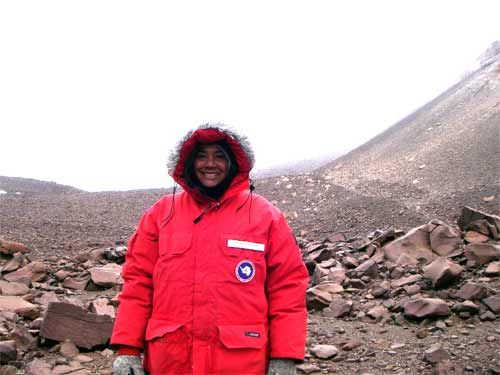Today the team took a hike to a "Bigfoot" location in Beacon Valley. "Bigfoot" is the name given by David Marchant to debris-covered glaciers with unique imprints left by sublimated ice. "Bigfoot" locations in the Dry Valleys are of further significance because they are analogous to features found on Mars. The Dry Valleys have been recognized as an important terrestrial analog for Mars due to the cold climate and similar landforms.
 The map shows the Bigfoot location in Beacon Valley relative to the drilling sites.
The map shows the Bigfoot location in Beacon Valley relative to the drilling sites.
The general sequence of events leading to "bigfoot" formation in Beacon Valley and on Mars is as follows (see the diagram below): Initially, snow and ice accumulation is sufficient to form glaciers as in the top portion of the diagram. Rock fall debris then covers the lower part of the glacier, creating a debris-covered glacier. Ice near the headwall (source) of the glacier remains relatively free of overlying debris as rock fall fragments tend to roll down the glacier to lower elevations. Hence, most debris-covered glaciers contain relatively clean ice in their upper reaches (top panel of diagram). To generate a "bigfoot" (i.e., hole), accumulation must decrease. (Curiously, in the Dry Valleys this typically means colder climate conditions, not warmer; the great cold retards precipitation and leads to starved glaciers). As these starved glaciers sublime, a bigfoot is formed: clean ice near the headwall is lost, but ice protected beneath debris down glacier remains. This gives rise to a sublimation hollow, informally termed a "bigfoot" (bottom panel of diagram). The same process may occur on Mars. For more information on a typical a Martian bigfoot, see a recent paper by Dave and his colleagues (Formation of gullies on Mars: Link to recent climate history and insolation microenvironments implicate surface water flow origin). Take a close look at figure 3a, and compare it with the figure below. The paper is included as an attachment below.
 Diagrams illustrating a debris glacier (top) and a Bigfoot (bottom).
Diagrams illustrating a debris glacier (top) and a Bigfoot (bottom).
The "Bigfoot" depression visited by the team was approximately 300 m in diameter and 50 m deep.
 Aerial view of Bigfoot location visited by the team.
Aerial view of Bigfoot location visited by the team.
 Jackie Hams in Bigfoot.
Jackie Hams in Bigfoot.
 The team is in the bottom of Bigfoot.
The team is in the bottom of Bigfoot.
Stay tuned to learn all about drilling through the ice in Beacon Valley.

